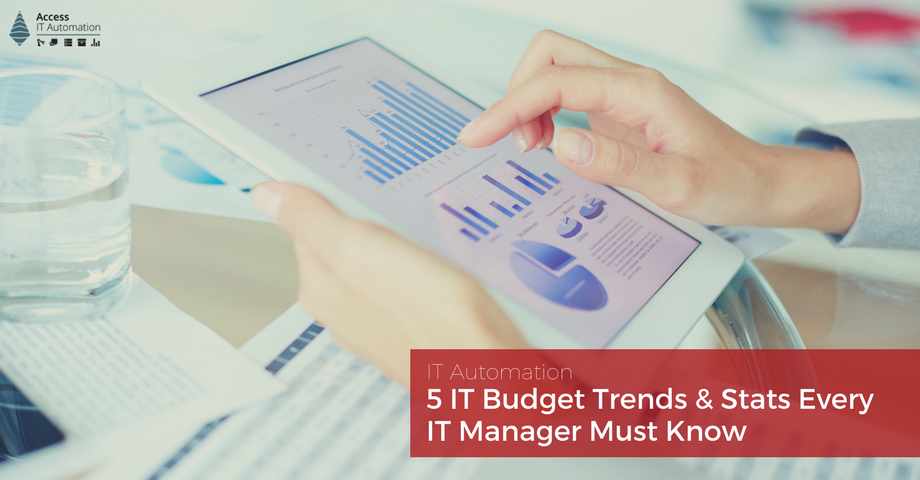Whether you are gathering trends and statistics for a presentation or business case to convince your executive management, board of directors, or other key stakeholders to increase your IT budget, up your internal IT staff numbers, or invest in emerging technologies to power your Digital Transformation, pulling together reliable data to back up your arguments can be a pain in the neck.
Over the last months, we have written dozens of articles about IT automation and we have come across some incredible insights — some of which I want to share with you today in the hope they’ll make your job easier.

Almost Half The Companies Will Sharply Increase IT Budgets In 2018
According to the State of IT Report 2018, 44% of companies asked expect their IT budgets to increase in 2018, while 43% anticipate no change at all and only 11% are planning to decrease their IT spendings. Of the companies that earmarked more money this year, budgetary gains are expected to be significant — an average of 19%!
This jump is caused by the ever-increasing technology dependence in the workplace as well as major IT modernization initiatives, such as a Windows 10 upgrade and Digital Business Transformation.
CapEx Spending Is On A Sharp Decline
There is another interesting fact if you dig a little bit deeper into budget distribution. According to the Computer Economics Report “IT Spending, Staffing, and Technology Trends 2017/2018“, the percentage of IT budget that is dedicated to capital spending is at a five-year low — declining from 24% (2013) to 18%. In the last year, the reduction was especially significant as it dropped by three percentage points.
While in the past, increased captial expenses were associated with a flourishing economy as businesses invested more, this is no longer the case. As more and more companies invest in cloud and virtualization technologies, larger CapEx expenses dwindle away. Most of today’s capital expenditures go towards modernizing existing infrastructure or legacy business applications.
One perfect example for this is the rise of Office 365. Over the past 24 months, we have increasingly been asked to help our customers to move away from physical, on-premise Exchange 2010 to off-premise Office 365 environments. Why? Because by moving to the cloud, enterprises are not only able to realize tremendous savings on hardware for Exchange 2016, but they get faster and more frequent feature updates as well, resulting in a quicker learning curve and less big-bang migrations. On the other hand, this means trusting off-premise SaaS and PaaS solutions with an outside vendor, like Microsoft.
Digital Transformation Spending Will Reach $1.7 Trillion By The End Of 2019
If CapEx spending is on a decline, but overall IT budgets are going up, where do companies invest their money instead? The answer is simple: Digital Business Transformation which is all about leveraging emerging technologies, such as Artificial Intelligence, automation, Bots, Internet of Things (IoT), cloud computing, and more, to create outstanding customer experiences that will create a lasting competitive advantage.
The analyst firm IDC expects that by 2020, “60% of all enterprises will have fully articulated an organization-wide digital platform strategy, and will be in the process of implementing it”. Furthermore, one out of two CEOs (47%) say they are pressured by their board of directors to drive digital innovation according to a recent Gartner survey — and with good reason. For more than half of those CEOs (56%), that pressure shows positive return on investment in the form of increased profits.
To make this possible, companies will spend more than $1.7 trillion worldwide on Digital Transformation by the end of 2019 — that is a whopping increase of 42% from 2017!
IT Automation Investments Planned For 2018
If you look at what organizations are planning to spend their increased IT budgets on, the 2018 State of IT Report holds another interesting data point: 51% of companies with more than 5,000 employees say they already use some form of IT automation, and 22% are planning to invest in it within the next 12 months.
While IT automation certainly isn’t the only technology enterprises are investing in, it is one of the top ones — together with advanced security, SDS / Virtual SAN, Infrastructure-as-a-Service, and Platform-as-a-Service, more.
IT Has To Do More With Fewer Hands
While 72% of large businesses plan on increasing their IT staff in 2018, the number of new employees in IT will not increase at the same pace as the revenue grows or new end users join the corporation. So, IT will have to adjust to handling a much bigger workload with fewer hands. This sentiment is also reflected in the fact that the IT spending per user has gone down from $7,231 to $6,843 since last year — hitting another 5-year low.
Therefore, IT has to become more efficient and productive than it ever has been and use virtualization, cloud computing, and IT automation wherever possible. For example, by deploying IT automation, an IT professional can now manage more than 500 devices, whereas he could only handle 125-150 devices if he had to manage them manually.
What IT trends do you really see taking off in 2018? Are you planning to invest in emerging technologies? We would love to hear from you in the comments.